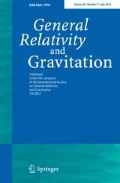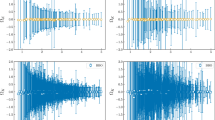Abstract
After the approval by the Italian Space Agency of the LARES satellite, which should be launched at the end of 2009 with a VEGA rocket and whose claimed goal is a ≈1% measurement of the general relativistic gravitomagnetic Lense–Thirring effect in the gravitational field of the Earth, it is of the utmost importance to reliably assess the total realistic accuracy that can be reached by such a mission. The observable is a linear combination of the nodes of the existing LAGEOS and LAGEOS II satellites and of LARES able to cancel out the impact of the first two even zonal harmonic coefficients of the multipolar expansion of the classical part of the terrestrial gravitational potential representing a major source of systematic error. While LAGEOS and LAGEOS II fly at altitudes of about 6,000 km, LARES should be placed at an altitude of 1,450 km. Thus, it will be sensitive to much more even zonals than LAGEOS and LAGEOS II. Their corrupting impact has been evaluated up to degree ℓ = 70 by using the sigmas of the covariance matrices of eight different global gravity solutions (EIGEN-GRACE02S, EIGEN-CG03C, GGM02S, GGM03S, JEM01-RL03B, ITG-Grace02s, ITG-Grace03, EGM2008) obtained by five institutions (GFZ, CSR, JPL, IGG, NGA) with different techniques from long data sets of the dedicated GRACE missions. It turns out to be ≈100–1,000% of the Lense–Thirring effect. An improvement of 2–3 orders of magnitude in the determination of the high degree even zonals would be required to constrain the bias to ≈1–10%.
Similar content being viewed by others
References
Ciufolini I.: Phys. Rev. Lett. 56, 278 (1986)
Ciufolini I.: N. Cim. A 109, 1709 (1996)
Ciufolini, I.: LARES/WEBER-SAT, frame-dragging and fundamental physics (preprint, 2004). (gr-qc/0412001v3)
Ciufolini, I.: On the orbit of the LARES satellite (preprint, 2006). (gr-qc/0609081v1)
Ciufolini I. et al.: LARES Phase A. University La Sapienza, Rome (1998)
Ciufolini, I.: Downloadable at http://www.infn.it/indexen.php→ASTROPARTICLEPHYSICS→ Calendarioriunioni→Roma,30gennaio2008→14:30AggiornamentoLARES(20’)→lares_dellagnello. pdf, p. 17 (2008)
Everitt C.W.F.: The Gyroscope Experiment I. In: General, description, analysisofgyroscopeperformance. Bertotti, B. (eds) Proc. Int. School Phys. “Enrico Fermi” Course LVI, pp. 331–60. New Academic Press, New York (1974)
Everitt C.W.F. et al.: Gravity Probe B: Countdown to Launch in Gyros, Clocks. In: Lämmerzahl, C., Everitt, C.W.F., Hehl, F.W. (eds) Interferometers...: Testing Relativistic Gravity in Space, pp. 52–82. Springer, Berlin (2001)
Förste, C., et al.: A new high resolution global gravity field model derived from combination of GRACE and CHAMP mission and altimetry/gravimetry surface gravity data. EGU General Assembly 2005 Vienna, AT, 24–29 April 2005
Inversi P., Vespe F.: Adv. Space Res. 14, 73 (1994)
Iorio L.: Class. Quantum Grav. 19, L175 (2002)
Iorio L.: Celest. Mech. Dyn. Astron. 86, 277 (2003)
Iorio L.: New Astron. 10, 616 (2005)
Iorio, L.: J. Cosmol. Astropart. Phys. JCAP07 (2005)008 (2005)
Iorio L.: Planet. Space Sci. 55, 1198 (2007)
Iorio L.: Europhys. Lett. 80, 40007 (2007)
Iorio L., Lucchesi D.M., Ciufolini I.: Class. Quantum Grav. 19, 4311 (2002)
Kaula W.M.: Theory of Satellite Geodesy. Blaisdell, Waltham (1966)
Lense J., Thirring H.: Phys. Z. 19, 156 (1918)
Lucchesi D.M.: Planet. Space Sci. 49, 447 (2001)
Lucchesi D.M.: Planet. Space Sci. 50, 1067 (2002)
Lucchesi D.M.: Geophys. Res. Lett. 30, 1957 (2003)
Lucchesi D.M.: Celest. Mech. Dyn. Astron. 88, 269 (2004)
Lucchesi, D.M., Paolozzi, A.: A cost effective approach for LARES satellite XVI Congresso Nazionale AIDAA, Palermo, IT, 24–28 September 2001
Lucchesi D.M., Ciufolini I., Andrés J.I., Pavlis E.C., Peron R., Noomen R., Currie D.G.: Planet. Space Sci. 52, 699 (2004)
Mashhoon B.: Gravitoelectromagnetism: a brief review. In: Iorio, L. (eds) The Measurement of Gravitomagnetism: A Challenging Enterprise., pp. 29–39. NOVA, Hauppauge (2007)
Mayer-Gürr, T., Eicker, A., Ilk, K.-H.: ITG-GRACE02s: a GRACE gravity field derived from short arcs of the satellite’s orbit. In: First Int. Symp. of the International Gravity Field Service “Gravity field of the earth”, Istanbul, TR, 28 August–1 September 2006
Mayer-Gürr, T.: ITG-Grace03s: the latest GRACE gravity field solution computed in Bonn. In: Joint Int. GSTM and DFG SPP Symp., Potsdam, D, 15–17 October 2007. http://www.geod.uni-bonn.de/itg-grace03.html
Milani A., Nobili A.M., Farinella P.: Non-Gravitational Perturbations and Satellite Geodesy. Adam Hilger, Bristol (1987)
Pavlis, N.K., et al.: Paper presented at the 2008 General Assembly of the European Geosciences Union, Vienna, 13–18 April 2008
Pfister H.: Gen. Relativ. Gravit. 39, 1735 (2007)
Pugh, G.E.: WSEG Research Memorandum No. 11 (1959)
Reigber Ch., Schmidt R., Flechtner F., König R., Meyer U., Neumayer K.-H., Schwintzer P., Zhu S.Y.: J. Geodyn. 39, 1 (2005)
Ries, J.C., Eanes, R.J., Watkins, M.M., Tapley, B.: Joint NASA/ASI Study on Measuring the Lense–Thirring Precession Using a Second LAGEOS Satellite. CSR-89-3. The University of Texas at Austin: Center for Space Research (1989)
Ries J.C., Eanes R.J., Tapley B.D.: Lense–Thirring precession determination from laser ranging to artificial satellites nonlinear gravitodynamics. In: Ruffini, R.J., Sigismondi, C. (eds) The Lense–Thirring Effect., pp. 201–211. World Scientific, Singapore (2003)
Ruggiero, M.L., Tartaglia, A.: N. Cim. B 1179, 743 (2002)
Schiff L.: Phys. Rev. Lett. 4, 215 (1960)
Tapley B.D. et al.: J. Geod. 79, 467 (2005)
Tapley, B.D., Ries, J., Bettadpur, S., Chambers, D., Cheng, M., Condi, F., Poole, S.: American Geophysical Union, Fall Meeting, abstract #G42A-03 (2007)
Van Patten R.A., Everitt C.W.F.: Phys. Rev. Lett. 36, 629 (1976)
Van Patten R.A., Everitt C.W.F.: Celest. Mech. Dyn. Astron. 13, 429 (1976)
Vespe F.: Adv. Space Res. 23, 699 (1999)
Author information
Authors and Affiliations
Corresponding author
Rights and permissions
About this article
Cite this article
Iorio, L. Will the recently approved LARES mission be able to measure the Lense–Thirring effect at 1%?. Gen Relativ Gravit 41, 1717–1724 (2009). https://doi.org/10.1007/s10714-008-0742-1
Received:
Accepted:
Published:
Issue Date:
DOI: https://doi.org/10.1007/s10714-008-0742-1




